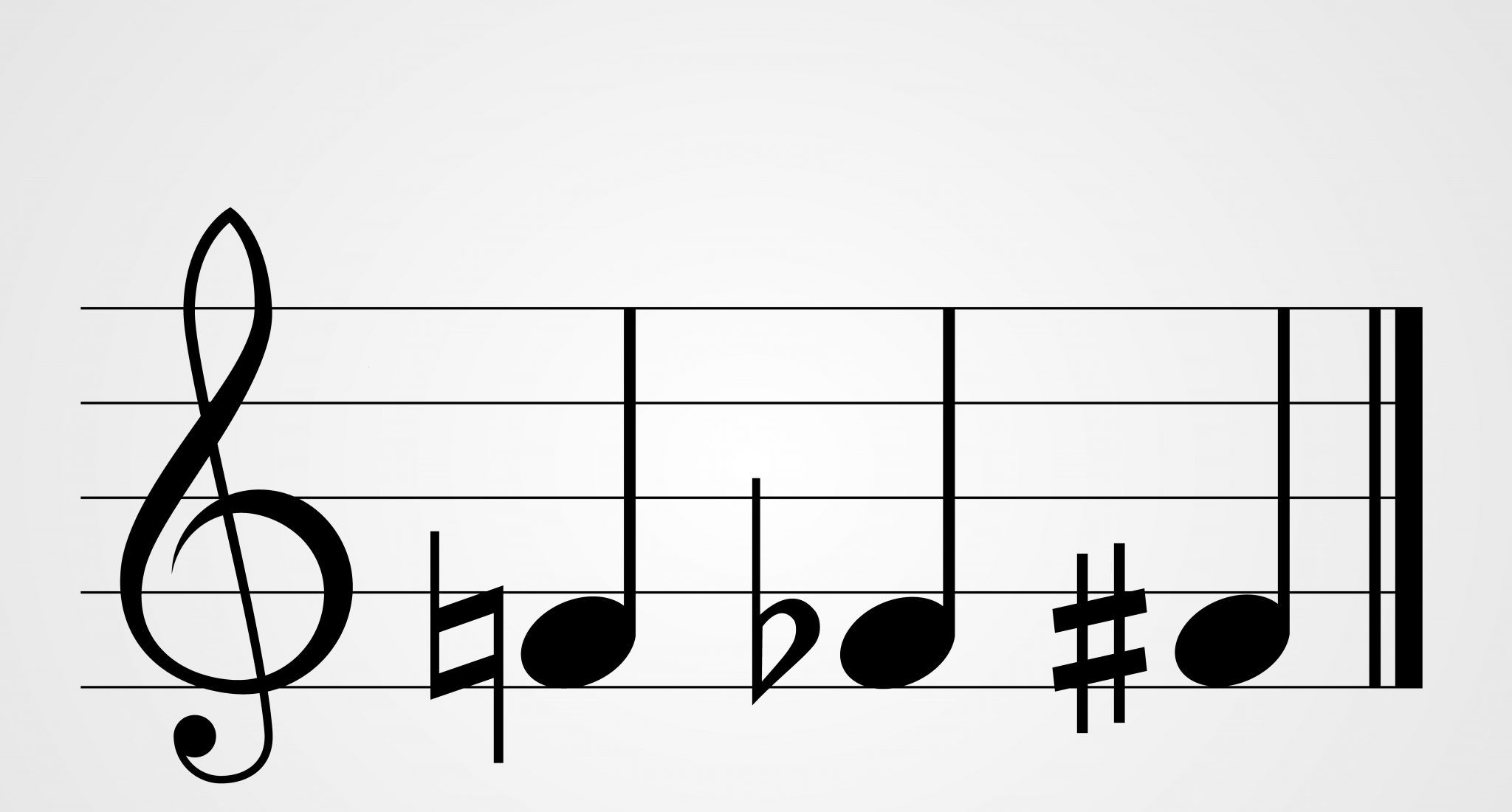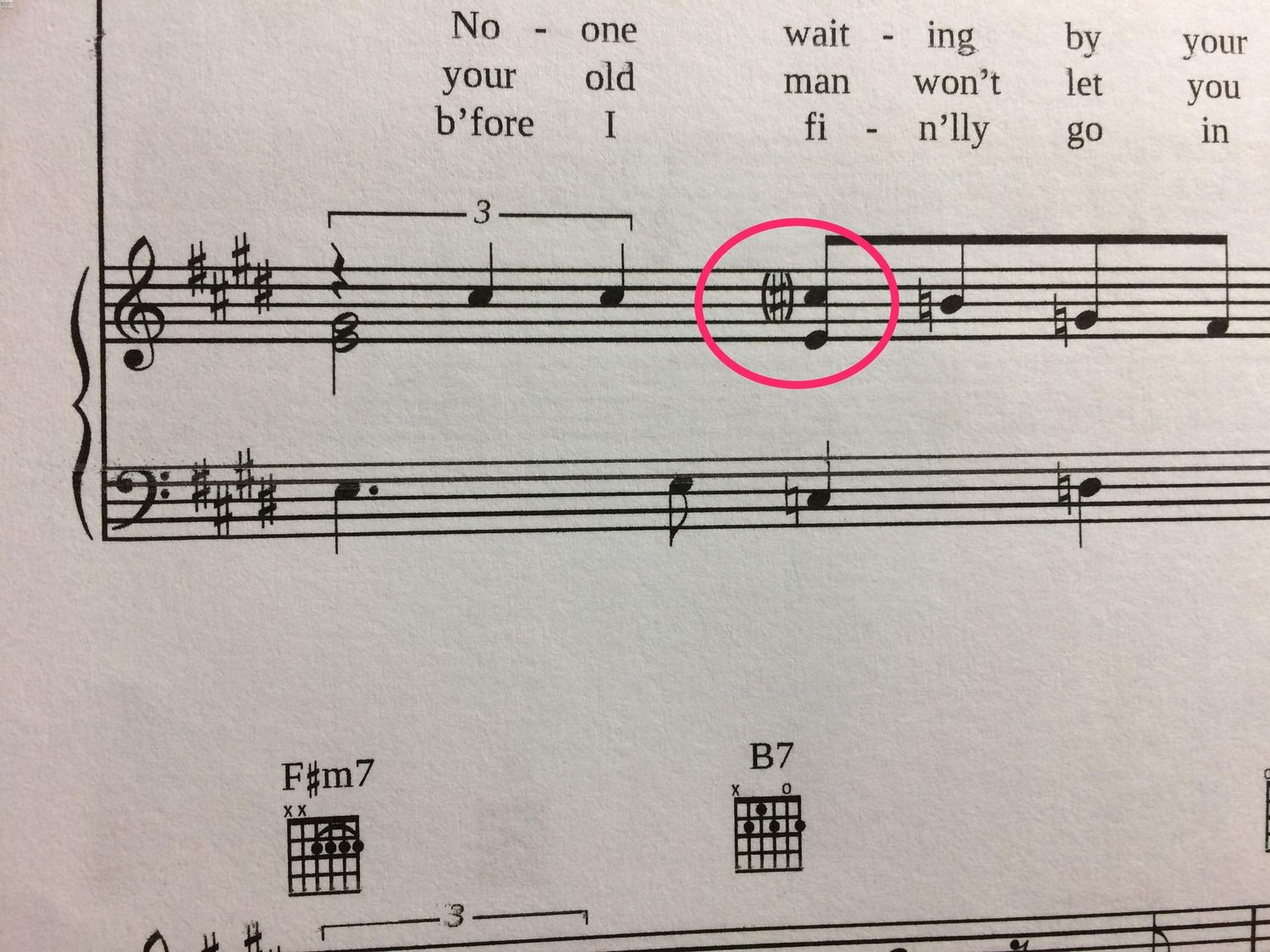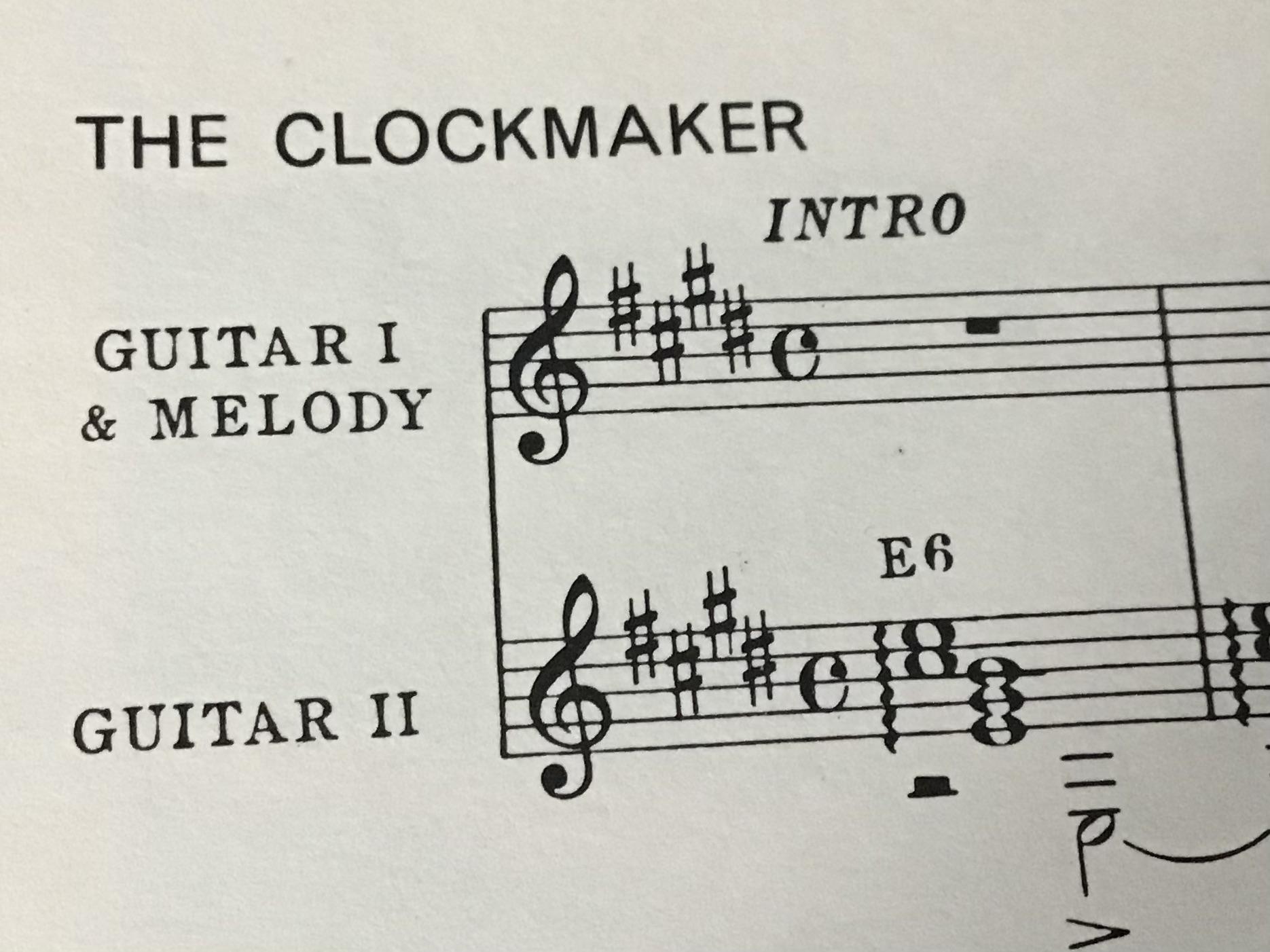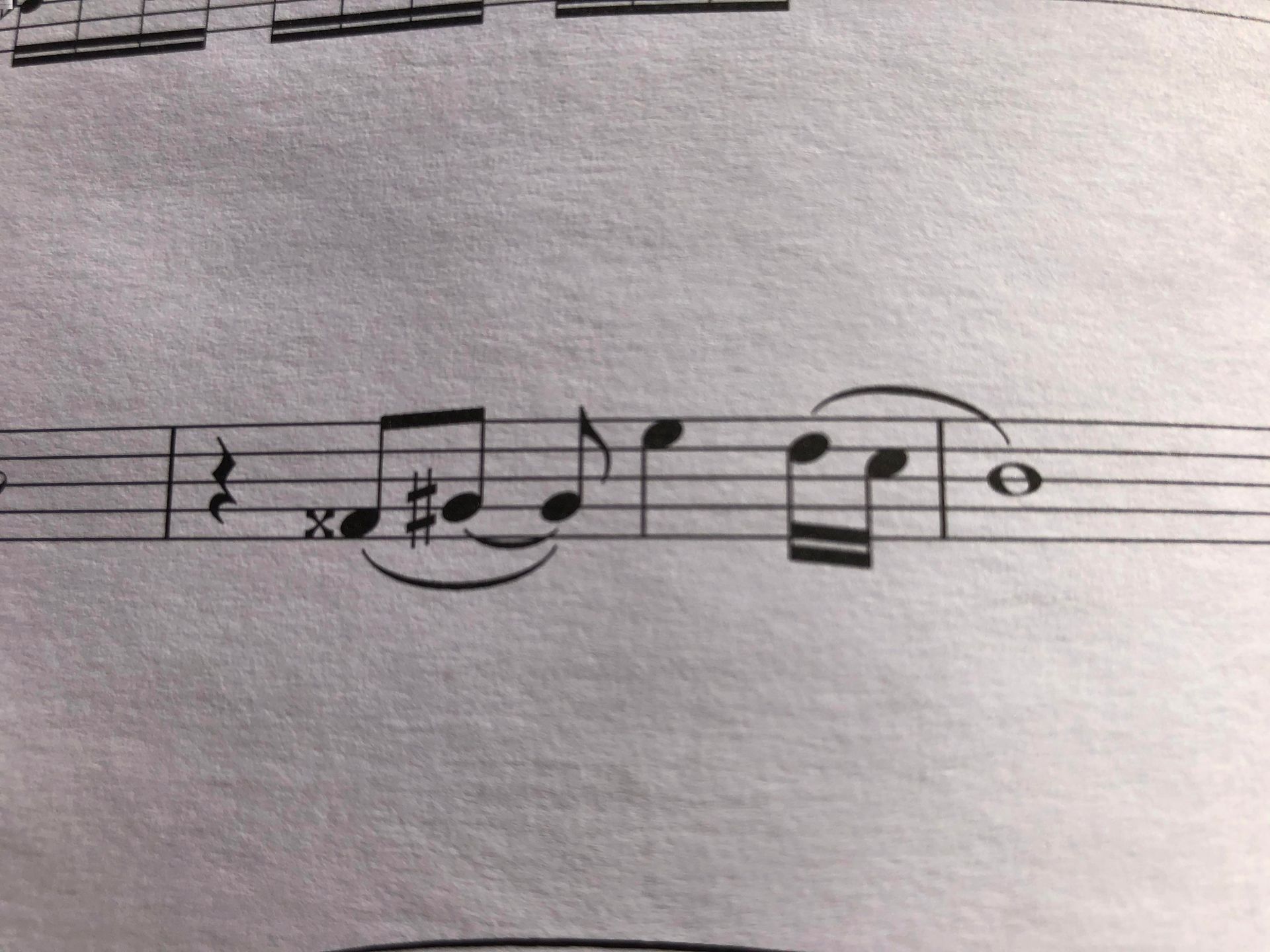Home>Production & Technology>Sheet Music>What Do Small Notes In Sheet Music Mean
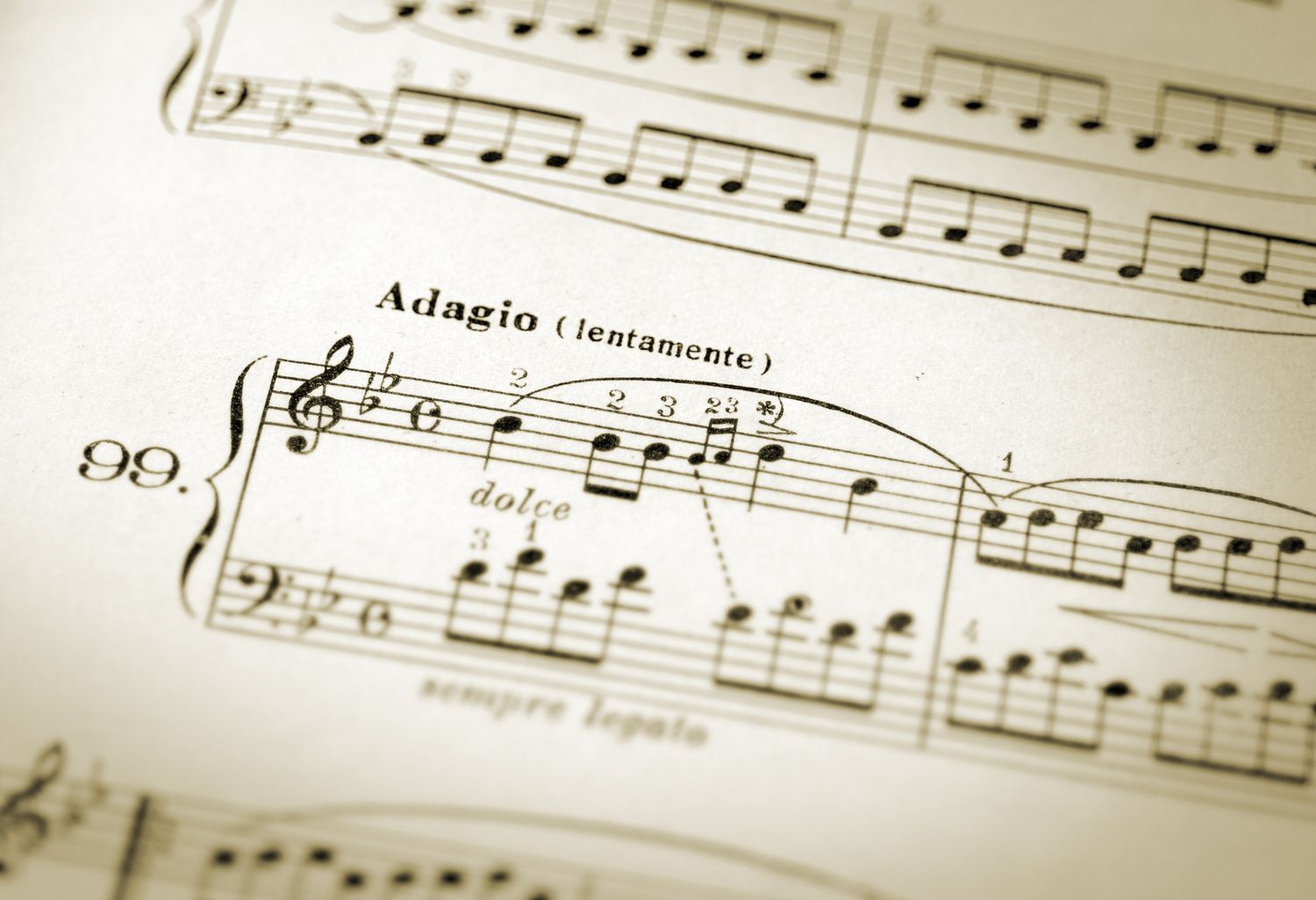

Sheet Music
What Do Small Notes In Sheet Music Mean
Published: December 3, 2023
Learn about the small notes in sheet music and their meanings. Enhance your understanding of sheet music with this informative guide.
(Many of the links in this article redirect to a specific reviewed product. Your purchase of these products through affiliate links helps to generate commission for AudioLover.com, at no extra cost. Learn more)
Table of Contents
Introduction
Sheet music is a universal language that allows musicians to communicate through written notation. Every aspect of a musical composition is meticulously represented on the sheet music, from the melody and harmonies to the dynamics and tempo. One crucial element that often goes unnoticed, yet holds significant importance, is the presence of small notes.
In sheet music, small notes are used to convey specific musical information and nuances that enhance the overall interpretation and performance of a piece. These diminutive symbols, often overlooked by novice musicians, can have a profound impact on the musical expression and the overall character of the composition.
In this article, we will explore the role and significance of small notes in sheet music. We will delve into different types of small notes, such as grace notes and cue notes, and discuss their interpretation and usage in various musical genres. By understanding the purpose and meaning behind these small notes, musicians can elevate their performances and bring out the true essence of the music.
The Importance of Small Notes in Sheet Music
Small notes may appear insignificant at first glance, but they play a crucial role in the interpretation and performance of sheet music. They provide valuable musical information that enriches the overall musical experience and adds depth to the composition. Here are some reasons why small notes are essential:
- Nuance and Expression: Small notes are used to indicate subtle nuances, ornamentations, and special techniques that bring life to a piece of music. They provide specific instructions to the performer in terms of articulation, phrasing, and dynamic variations, allowing them to convey the composer’s intended expression with precision.
- Rhythmic Precision: Small notes often play a critical role in maintaining the rhythmic accuracy of a piece. Grace notes, for example, function as quick ornaments and add rhythmic embellishments, enhancing the overall rhythmic complexity and adding flair to the performance.
- Contrast and Emphasis: Small notes can be used to create contrast and highlight important melodic or rhythmic elements within a piece. By contrasting small notes with regular-sized notes, composers draw attention to specific musical phrases or thematic motifs, guiding the performer to emphasize certain passages.
- Character and Style: Small notes are also instrumental in defining the character and style of a particular musical composition. They can convey a sense of playfulness, elegance, or drama, depending on how they are used. For instance, cue notes in jazz or swing music signify short, syncopated bursts of sound that contribute to the distinct rhythmic style of the genre.
- Historical Context: In some cases, small notes in sheet music hold historical significance. They may represent authentic ornamentations and embellishments from specific musical eras or genres, enabling musicians to capture the essence of the time period and perform the music in an historically-informed manner.
Understanding the importance of small notes in sheet music allows musicians to fully grasp the composer’s intentions and breathe life into the composition. By paying attention to these seemingly insignificant symbols, performers can elevate their interpretations, add nuance and emotion, and truly connect with the soul of the music.
Types of Small Notes
Small notes come in different forms and serve various purposes in sheet music. Let’s explore some of the most common types:
- Grace Notes: Grace notes, also known as ornamentation notes, are small, quick notes that are played as embellishments to a melody. They are usually written in smaller font and placed before a regular-sized note. Grace notes add decoration, expression, and rhythmic complexity to a piece, often enhancing its musicality and virtuosity.
- Cue Notes: Cue notes are small notes added above or below the staff to provide a reference or reminder to the performer. They are often used when an instrument has a long period of rest and needs a cue to enter back into the music. Cue notes are typically written in smaller font and are easily recognizable by their smaller stems or note heads.
- Keyboard Cue Notes: Keyboard cue notes are small notes specifically written for piano or keyboard instruments. These notes are not meant to be played by the performer but are provided as a reference to indicate harmony or melodies played by other instruments. Keyboard cue notes are typically written as smaller-sized notes above or below the grand staff.
- Turns and Trills: Turns and trills are small notes placed above or below a regular-sized note to indicate a rapid alternation between that note and its neighboring note(s). These ornamentation techniques create a shimmering effect and add flair to the music. Turns are typically denoted by a small “S”-shaped line with additional small notes, while trills are represented by a squiggly line with the letters “tr” or a trill symbol.
- Appogiaturas and Acciaccaturas: Appogiaturas and acciaccaturas are small notes used to indicate a quick grace note played before the main note. An appogiatura is written as a small note with a stroke through its stem, while an acciaccatura is written as a small note with a small diagonal line through its stem. These types of small notes are used to create expressive and dramatic embellishments.
Each type of small note serves a unique purpose and adds a distinct musical element to a composition. By understanding and interpreting these small notes correctly, musicians can bring out the intended expressive and stylistic qualities of the music, elevating their performances to a higher level.
Grace Notes
Grace notes, also known as ornamentation notes, are small, embellishing notes that are played quickly and often serve to enhance the musical expression and virtuosity of a composition. Here is a closer look at grace notes and their significance in sheet music:
Grace notes are typically written in smaller font and placed before a regular-sized note. They are played as additional, non-essential notes that add decorative elements to a melody. While grace notes are not always indicated with precise rhythmic values, they are usually played in a quick, fluid manner, fitting into the surrounding musical phrases.
There are several types of grace notes, including:
- Acciaccatura: An acciaccatura, also known as a short appogiatura, is a grace note that is played extremely quickly and is emphasized by an audible “crushed” sound. It is represented by a small note with a diagonal line through the stem. Acciaccaturas are often used for dramatic effect or as expressive ornaments.
- Appogiatura: An appogiatura is a grace note that is played slightly longer than an acciaccatura. It is denoted by a small note with a stroke through its stem. Appogiaturas add expressive and emotional elements to the melody and are typically resolved to the following main note. They can create tension or a sense of longing in the music.
- Upper Mordent: An upper mordent is a grace note that is performed by playing the main note, followed by a quick alternation between the main note and the note above it. It is represented by a small squiggle line above the main note. Upper mordents add a trilling effect and create ornamentation and embellishments in the music.
- Lower Mordent: A lower mordent is a grace note that functions similarly to an upper mordent, but the quick alternation occurs between the main note and the note below it. It is denoted by a small squiggle line below the main note. Lower mordents provide a contrasting ornamentation and add complexity to the musical phrases.
Grace notes are not only aesthetically pleasing, but they also contribute to the overall musicality and interpretation of a piece. They allow performers to add their own personal touch and style to the music, showcasing their technical skills and artistic expression.
It is important for musicians to interpret and play grace notes in a manner that aligns with the overall mood and style of the composition. By doing so, they can bring out the intended ornamentation, expression, and refinement that grace notes offer, elevating the musical performance to new heights.
Cue Notes
Cue notes play a crucial role in sheet music, providing reference points and reminders for musicians during a performance. They are small notes that are added above or below the staff and serve as cues to indicate when an instrument should enter after a period of rest. Let’s explore more about cue notes and their significance:
Cue notes are often written in a smaller font and have distinct visual characteristics, such as smaller stems or note heads. They act as guideposts, allowing musicians to navigate the music accurately, especially when they have been silent for a certain duration. Cue notes help maintain synchronization among different instruments and ensure smooth transitions in ensemble performances.
These notes are particularly helpful in music with complex arrangements or sections where instruments have extended rests. By providing a visual reminder, cue notes help musicians re-enter the music seamlessly, avoiding any potential confusion or missed entrances. They serve as cues to remind musicians of their entry point and assist in maintaining overall cohesion within the ensemble.
Cue notes are not limited to providing entry points alone. They can also indicate specific cues for musical elements such as dynamic changes, rhythmic hits, or important melodic lines played by other instruments. In such cases, cue notes act as signposts, directing musicians’ attention to specific parts of the music and enhancing their overall awareness and coordination within the ensemble.
While cue notes are primarily used in ensemble performances, they can also be beneficial for solo musicians. In solo repertoire, cue notes may indicate sections where the performer requires a specific reference point or reminder to ensure accuracy during intricate passages or complex rhythms.
Interpreting and utilizing cue notes effectively requires careful attention to both the notation and the musical context. Musicians need to be familiar with the score and ensure they understand the timing and location of their cues. By incorporating cue notes into their practice routines, musicians can anticipate their entries and transitions, resulting in seamless performances.
Overall, cue notes play a vital role in facilitating ensemble communication, helping musicians navigate complex compositions, and ensuring a cohesive and well-coordinated musical performance.
Keyboard Cue Notes
Keyboard cue notes serve as valuable references in sheet music specifically for piano and other keyboard instruments. These small notes, usually written above or below the grand staff, indicate harmonies, melodies, or other musical elements played by instruments other than the keyboard. Here’s a closer look at keyboard cue notes and their significance:
Keyboard cue notes are written in a smaller font compared to the regular-sized notes on the staff. They are intended to provide the pianist with essential cues, allowing them to understand and interpret how their part fits within the larger ensemble or arrangement. These cues are designed to facilitate coordination and musical awareness, ensuring that the pianist plays their part in harmony with other instruments or vocalists.
By including keyboard cue notes, composers and arrangers help piano players understand the overall musical structure and context. These notes may indicate important melodic lines, harmonies, or rhythmic patterns performed by other instruments that contribute to the overall texture of the composition. By being aware of these cues, pianists can create a more cohesive and synchronized musical performance.
Keyboard cue notes also assist pianists in accompanying vocalists or solo instrumentalists. They serve as references for the specific pitches, rhythms, or dynamics that need to be played to support and enhance the soloist’s performance. Additionally, in musical theater or opera scores, keyboard cue notes may indicate cues for specific dialogues, entrances, or key moments in the dramatic narrative.
Interpreting keyboard cue notes requires attentiveness from the pianist. The ability to quickly identify and internalize these cues allows for smoother transitions, accurate timing, and a more nuanced and cohesive performance. Pianists must develop the skill of seamlessly transitioning between their primary part and the cues provided by the keyboard cue notes.
Keyboard cue notes can greatly enhance a piano player’s understanding and interpretation of a piece of music. By paying attention to these small but significant cues, pianists can better align their playing with the overall musical arrangement, resulting in a more cohesive and impactful performance.
Whether accompanying other instruments or providing support to vocalists, keyboard cue notes are essential in helping pianists fulfill their role within an ensemble, contributing to a unified and harmonious musical experience.
How to Interpret Small Notes
Interpreting small notes in sheet music requires careful observation and understanding of their intended purpose. Here are some essential guidelines to help musicians interpret small notes:
- Pay Attention to Context: Context is key when interpreting small notes. Consider the musical phrases, dynamics, and overall style of the composition. Understanding the context will provide insights into the role and significance of the small notes in relation to the larger musical structure.
- Refer to Musical Notation Guidelines: Familiarize yourself with the conventional notation symbols for small notes, such as grace notes or cue notes, and their associated markings. Learn how these symbols are typically represented and how they are intended to be performed.
- Consult Performance Practice: Study the performance practices and stylistic conventions of the musical era or genre in which the piece was composed. This knowledge will aid in deciphering ornamentation, embellishments, and other small note indications specific to that particular musical style.
- Follow Artistic Direction: Observe any performance indications provided by the composer, such as instructions for dynamics, phrasing, or articulation. These indications often accompany small notes and provide crucial guidance on how to interpret and incorporate them into your performance.
- Listen to Recordings or Seek Guidance: Seek inspiration from professional recordings or consult with experienced musicians to gain insights into how small notes are performed in specific musical compositions. Listening to different interpretations can help you develop your own artistic approach.
- Experiment and Explore: While there may be conventions for interpreting small notes, don’t be afraid to experiment and explore different possibilities. Use your musical intuition and creativity to find your unique interpretation, always considering the intended musical expression and the overall character of the composition.
- Balance Precision with Musicality: While it is crucial to interpret small notes accurately, remember to balance technical precision with musicality. Small notes should enhance the music and serve the expressive intent of the composition. Avoid being overly mechanical and strive to infuse your performance with emotion and artistic expression.
Interpreting small notes requires a combination of technical awareness, musical understanding, and artistic interpretation. By following these guidelines and immersing yourself in the musical context, you can bring out the intended nuances and musical beauty of the composition through your performance.
Remember that interpretation is subjective, and while guidelines provide a foundation, ultimately, it is the performer’s own musical instinct and expression that breathe life into the small notes, creating a unique and captivating performance.
Use of Small Notes in Different Genres
The use of small notes in sheet music varies across different musical genres, each with their own unique conventions and stylistic tendencies. Here’s a look at how small notes are utilized in various genres:
- Classical Music: In classical music, small notes are often employed as grace notes or ornamentations to add embellishment and expressiveness. They enhance the phrasing and provide subtle nuances to the melody. Additionally, small notes are used in classical compositions to indicate trills, turns, and other standard ornamentation techniques that enhance the virtuosity and intricate nature of the music.
- Jazz: Small notes in jazz are frequently used as cue notes or rhythmic accents. They provide cues for instrumentalists to enter or play specific rhythms in syncopated jazz arrangements. Small notes may also indicate short, syncopated bursts known as “hits” or “stabs” that add a rhythmic punch to the overall performance.
- Pop and Rock: In pop and rock genres, small notes are often used as grace notes or cue notes, adding ornamentation and emphasizing specific melodic or rhythmic moments. They can also indicate quick rhythmic fills or specific instrumental motifs within the arrangement, helping to create a distinct musical identity for the song.
- Folk and Traditional Music: Small notes in folk and traditional music are commonly used for ornamentation, such as grace notes or trills, which add a traditional and authentic flavor to the melody. These small notes contribute to the distinctive ornamented style of the genre and showcase the individuality of the performer.
- Musical Theater: In musical theater compositions, small notes can serve multiple purposes. They may indicate cue notes for actors or provide reference points for specific dialogues or entrances. Small notes can also represent character-specific musical motifs or highlight notable melodic phrases sung by other performers.
- World Music: Various world music genres have their own unique uses for small notes. For example, in Indian classical music, small notes known as gamakas are used to add ornamentation and intricate melodic flourishes. In African music, small notes may indicate specific rhythmic patterns or embellishments played on traditional percussion instruments.
Understanding the use of small notes in different genres is crucial for performers to accurately interpret and present the music within its specific stylistic context. It allows musicians to capture the essence and authenticity of the genre while showcasing their technical skills and musicality.
By recognizing the conventions and applications of small notes across genres, performers can bring out the desired expressiveness, rhythm, and style required for each unique musical genre, resulting in an authentic and captivating performance.
Common Misinterpretations of Small Notes
Interpreting small notes in sheet music can sometimes be challenging, and musicians often encounter common misinterpretations. These misinterpretations can lead to inaccuracies in performances and affect the overall musicality of a piece. Here are some common misinterpretations of small notes to be aware of:
- Overlooking Dynamic Variations: Small notes are often used to indicate dynamic variations, such as soft or accented notes. One common misinterpretation is overlooking these markings, resulting in a lack of dynamic contrast and expressive impact. Paying careful attention to small note dynamics ensures a more nuanced and dynamic performance.
- Misapplying Grace Notes: One misinterpretation of grace notes is playing them with too much importance, giving them equal weight as the main notes. Grace notes should be played as quick embellishments, serving as decorative elements that lead into the main notes. Understanding their role as ornamentations is crucial to maintaining the overall flow and structure of the music.
- Ignoring Cue Notes: Cue notes are often overlooked or misunderstood, particularly in ensemble performances. Ignoring these small indicators can lead to missed entrances or timing issues when musicians need to rejoin the music after a rest. Paying attention to cue notes helps maintain synchronization and cohesion within the ensemble.
- Incorrect Articulation of Appogiaturas and Acciaccaturas: Appogiaturas and acciaccaturas are grace notes that require specific articulation. A common misinterpretation is playing them with equal duration as the main note or not giving them distinctive emphasis. Understanding their characteristic quickness and their role in adding expressive tension is essential to performing them accurately.
- Over-Ornamentation: Another misinterpretation of small notes is over-ornamentation. Adding excessive ornamentation or embellishments can overshadow the main melody and disrupt the overall musical balance. It’s important to strike a balance between ornamentation and the core melody, allowing the small notes to enhance rather than overpower the composition.
- Misidentifying Trills and Turns: Trills and turns are small notes used for ornamentation, but they have distinct characteristics. Misidentifying them and playing them incorrectly can result in inaccurate musical expression. Understanding the specific notation and execution of trills and turns is necessary to convey the intended embellishments accurately.
Awareness of these common misinterpretations can help musicians avoid inaccuracies and enhance their performances. It is crucial to study and thoroughly understand the notation, markings, and musical context surrounding small notes. Additionally, listening to professional recordings, consulting with knowledgeable musicians, and studying performance practices can provide further guidance in interpreting small notes correctly.
By being conscious of these common misinterpretations and striving for accurate and nuanced interpretations, musicians can deliver more authentic and engaging performances, capturing the essence and intent of the music accurately.
Conclusion
Small notes in sheet music may appear inconspicuous, but their significance should not be underestimated. These small symbols hold valuable information that enhances the interpretation and performance of a musical composition. From grace notes and cue notes to keyboard cue notes and other ornamentations, small notes contribute to the overall musical expression and character of a piece.
Understanding and interpreting small notes is essential for musicians to bring out the intended nuances, ornamentations, and expressive elements in the music. By paying attention to context, following notation guidelines, considering performance practices, and seeking artistic direction, performers can accurately elucidate the musical intentions conveyed by these small symbols.
Small notes have different roles and conventions in various musical genres, and they play a significant part in enhancing the musicality and mood of each genre. Whether in classical music with its intricate ornamentations, jazz with its syncopated cues, or pop and rock with their melodic emphasis, small notes contribute to the unique characteristics of each genre.
However, misinterpretations of small notes can lead to inaccuracies in performances. These misinterpretations include overlooking dynamic variations, misapplying grace notes, ignoring cues, incorrectly articulating appogiaturas and acciaccaturas, over-ornamentation, and misidentifying trills and turns. Being aware of these common misinterpretations helps musicians avoid inaccuracies and create more authentic and nuanced performances.
Ultimately, the interpretation and execution of small notes require a combination of technical proficiency, musical understanding, and artistic expression. By studying the notation, immersing oneself in the musical context, and embracing individual creativity, musicians can bring the music to life, capturing the intended nuances, emotions, and stylistic elements embedded within the small notes.
So, next time you encounter small notes in sheet music, pay attention to their significance, interpret them with care, and bring them to life in your performance. As you embrace the depth and intricacy of these small symbols, you will unlock new dimensions of musical expression and elevate your performance to new heights.

